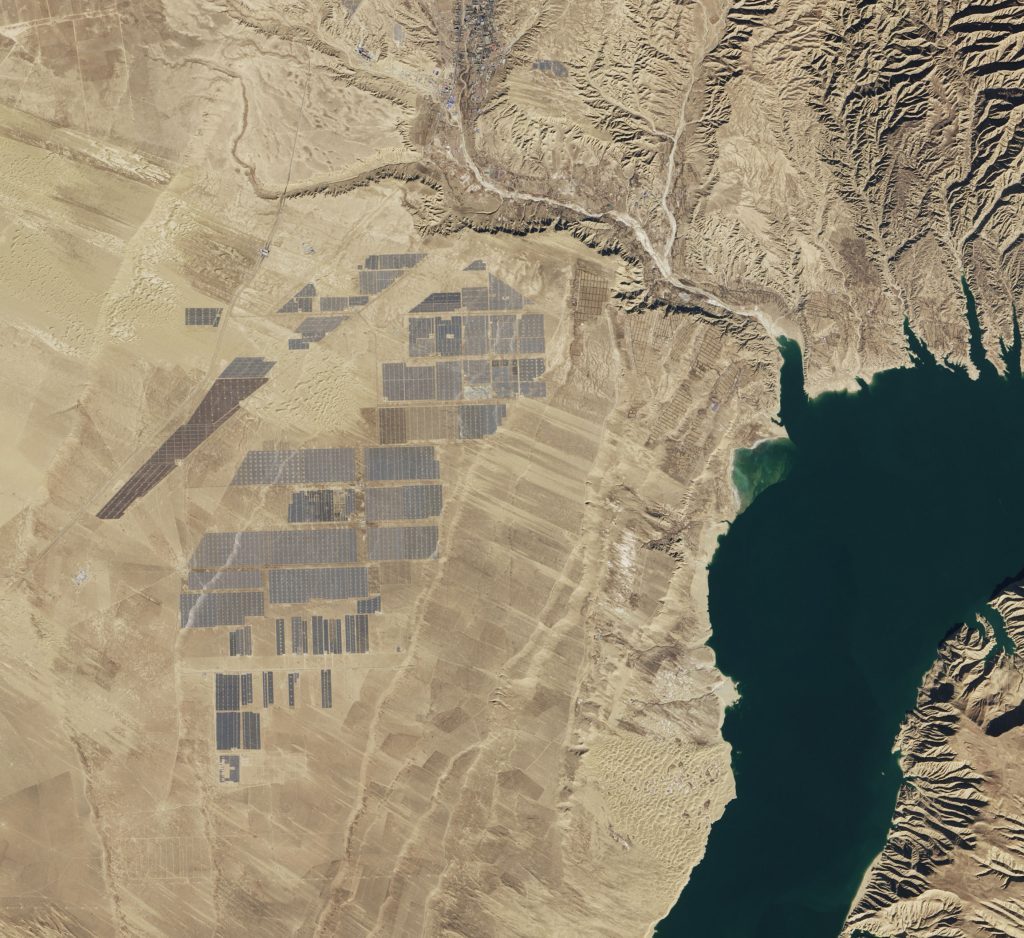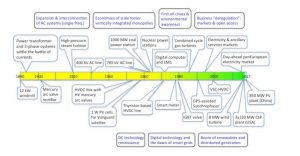 February 2017, Longyangxia Dam Solar Park in China, 850 MW of capacity. Image acquired by the Operational Land Imager (OLI) on Landsat 8. By January 5, 2017, solar panels covered 27 square kilometers (10 square miles) of Qinghai province. According to news reports, there were nearly 4 million solar panels at the site in 2017.
February 2017, Longyangxia Dam Solar Park in China, 850 MW of capacity. Image acquired by the Operational Land Imager (OLI) on Landsat 8. By January 5, 2017, solar panels covered 27 square kilometers (10 square miles) of Qinghai province. According to news reports, there were nearly 4 million solar panels at the site in 2017. Today’s structure and organization of electric energy systems obey a number of circumstances and technical milestones that took place mostly between the last quarter of the nineteenth century and the first quarter of the twentieth (past) century. If just two key actors of such a fascinating achievement had to be named, those would surely be the power transformer and the steam turbine, invented almost simultaneously.
Indeed, power transformers played a crucial role in quickly settling the fierce battle of currents between Edison and Tesla, by allowing high-voltage AC systems to transmit much more energy and much farther away than primitive DC low-voltage feeders (ironically, one century later the opposite is just happening). Less well known is the fact that sustained efficiency improvements and cost reduction of increasingly larger steam turbines fostered the interconnection and fast expansion of initially isolated and relatively small power systems.
Then, the advent of nuclear stations in the 1970s and combined-cycle gas turbines in the 1980s reinforced the steady trend towards a centralized and monopolistic production of electricity. For several decades, thermal stations ranging from 400 to over 1000 MW, located at strategic and usually distant places, were the rule, notable exceptions being hydro stations. Meanwhile, power engineers succeeded in designing sophisticated control systems, both automatic and operator-assisted, allowing synchronous generators to reliably track the evolution of the rather inelastic demand [1].
The rollout and consolidation of such a paradigm was accompanied by a drastic and continued reduction of electricity prices, bringing about profound changes in economically developed societies. On the negative side, this was achieved at the cost of wasting roughly two thirds of the (mostly fossil) primary energy used for power production, as the efficiency of thermal stations hardly reached 35% on average, for which huge amounts of refrigeration water had to be processed as well. Our energy-addict civilization hence lost the opportunity to satisfy its power needs by adopting cogeneration or trigeneration systems [2], with efficiencies easily exceeding 80%, such as those widely used for district heating in Northern Europe.
The new regulatory wave of the 1990s, aimed at removing the barriers and inefficiencies of monopolistic utilities by unbundling vertically integrated businesses, significantly changed the way energy was traded. Yet the basic centralized structure and energy flow patterns of the past decades remained essentially unchanged.
Soon after the oil crisis of 1973, a handful of motivated researchers started to design, build, and test rather exotic mockups of thermal solar stations in the deserts of Mojave (California) and Tabernas (Spain). Also, early in the 1980s, small and primitive wind farms were erected in New Hampshire, the Greek island of Kyathos, and elsewhere, followed in 1991 by the first offshore farm in Denmark (11×450 kW turbines). Nobody could then imagine that solar energy, including modular photovoltaic (PV) plants ranging in size from 1 kW to hundreds of megawatts, along with increasingly larger, electronically-aided wind generators (up to 8-MW offshore units), would become in just 25 years the cornerstones of a revolution in power production that is drastically changing the face and fate of power systems.
Indeed, a number of circumstances (rising fossil fuel prices, nuclear accidents, climate change awareness, public subsidies, technological innovations, etc.) have catapulted renewable sources, beyond traditional hydro and biomass, towards exponential growth rates in power capacity. In the last decade (2007-2016), the global cumulative installed capacity of wind energy has increased by over five-fold, from 94 to 490 GW [3]. But this pales when compared with PV capacity, which has increased over the same period from 9.4 to around 300 GW, i.e., by six times as much as wind power [4].
Excluding hydro, a total of 139 GW of renewable capacity was built worldwide in 2016, increasing the renewable share from 15% to 17%. This represents over 55% of the global capacity erected that year (90% in the case of Europe). In the U.S., wind generation capacity has already surpassed hydro capacity, both technologies enjoying similar capacity factors (34.7% wind and 38% hydro). Those figures were absolutely unimaginable just a decade ago. And this changing of the guard is taking place not only in Europe, the U.S., China, or Australia, but also in India, Brazil, South Africa, and many other countries [5].
In turn, the added capacity is leading to steadily growing rates of renewables penetration in the electricity mix. For instance, 42% of the electricity consumed in Denmark in 2015 came from wind farms. In Spain, a much larger and not so well interconnected country, wind energy was the main contributor to the electricity mix in 2013 (over 21% share), beating for the first time the pool of nuclear stations. In Portugal, all electricity came from hydro, wind and solar for four consecutive days in May 2016. In Germany, over 50% of the daily demand was produced by renewables on March 18, 2017.
The advent of nuclear stations in the 1970s and combined-cycle gas turbines in the 1980s reinforced the steady trend towards a centralized and monopolistic production of electricity.
Driven by technological innovation and massive production, renewables seem to have entered a virtuous circle delivering increasingly cheaper and more efficient plants. Early in 2017, the largest PV plant (Longyangxia Dam Solar Park, 850 MW on 23 km2) started operation in China in coordination with a conventional hydro station, bringing about many synergies between both technologies. The state-of-the-art technology in concentrated solar power is the 110-MW Crescent Dunes plant in the Nevada desert, where the sun directly heats the molten salts flowing through the solar tower. Its 50% capacity factor allows the plant to serve the night peak demand of Las Vegas.
Capital expenditure (CAPEX), one of the weakest points associated with renewables at the beginning of this race, has been drastically reduced over the last few years. Today 1 MW of onshore wind capacity barely exceeds US1million,whereas1MWpforaturnkeyPVprojectcostsbetweenUS1.3 and 2.2 million, depending on the size and location. Those CAPEX values lead to levelized costs of electricity (LCOE) quickly reaching the grid parity [6], which is distorting the equilibrium of ill-designed, day-ahead markets. According to [7], the electricity industry is moving from an OPEX into a CAPEX world, and the market and regulatory framework should evolve accordingly.
Auctions are becoming the rule around the world as the main way of allocating renewables capacity, sometimes resulting in rather shocking prices. While in 2010 solar energy was contracted at a global average price of almost US250/MWh,in2016theaveragepriceapproachedUS50/MWh [8]. So far, the lowest winning bids are in the order of US$30/MWh, both for PV and wind projects in Chile and Morocco, respectively, but those exceptionally low values cannot generally be projected to other countries with higher local costs.
Note, however, that 1 GW of renewables is approximately equivalent to 0.3 GW of fossil units in terms of average energy yield. Therefore, replacing for instance the 700 GW of fossil generators existing in the U.S., will need roughly about 2000 GW of renewables which, at the current pace, would take 100 years to complete. This is much longer than required by the ambitious decarbonization goals stated at the COP21 climate summit. In China, in spite of its 226 GW of wind and solar capacity, over 65% of all electricity was generated in 2016 by coal-fired plants. In fact, additions of coal-based capacity are still larger than those of renewables in many countries. For this reason, many believe that carbon capture and storage technology (CCS), still in its infancy, must enter the scene as well.
Yet a big unknown in this upcoming paradigm is how much production will be centralized, as in the past, and how much electricity will be locally produced, in a distributed manner. Huge cities clearly lack the space for enough renewable facilities to be deployed, capable of locally producing all the energy they need. Therefore, transmission systems interconnecting major load centers with remote energy hubs will always be necessary to a large extent (again, China is a good example, with more than 20 HVDC lines delivering hydro, coal and wind power from the inner regions to its eastern megacities). However, it is now evident that self-production will become in a few decades at least as relevant as remote generation, forcing distribution grids to be able to cope with bidirectional flows. Both kinds of generation will have to compete for an increasingly more efficient demand, capable of responding to spot price signals.
A big unknown in this upcoming paradigm is how much production will be centralized, as in the past, and how much electricity will be locally produced, in a distributed manner.
Be that as it may, very few people today question that renewables will constitute the bulk of electricity production at the turn of the next century. This does not mean, though, that the pathway to electricity decarbonization is free from big challenges and hurdles, the most important surely being the seasonal variability of renewable energy, for which no solution is yet envisioned. If future electricity systems are to be massively based on renewables, they must rely upon resilient, high-tech AC&DC grids, must be supervised from smarter energy management systems and, most important, must be endowed with ubiquitous energy storage systems, capable of providing long-term, back-up energy in a flexible manner when the wind does not blow or the sun does not shine. But that is another story….

Figure 1.Timeline showing the major milestones and stages in the development of electrical energy systems. Mainstream AC technologies are shown on top, while DC transmission, renewable generation, and smart grid technologies appear below.
The author is Professor of Power Engineering, University of Seville, Spain. Email: age@us.es.
Read full version of this article here.






 JOIN SSIT
JOIN SSIT